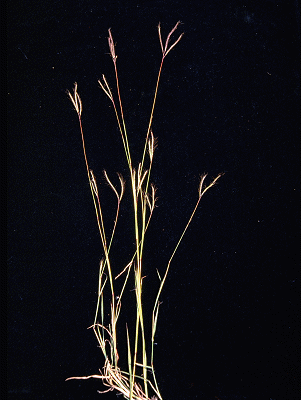 |
 |
|
 |
 |
|

Dichanthium aristatum (Poiret) C.E.Hubb. |
Common name
Angleton Grass
Derivation
Dichanthium Willemet, Ann. Bot. (Usteri) 18: 11 (1796).
From the Greek dicha (in two) and anthos (flowers), alluding to
the two kinds of spikelet pairs in the raceme.
aristatum- from the Latin arista (bristle) and -ata (possessing). The apices of lemmas, paleas or glumes drawn out into a distinct awn.
Published in
Bull. Misc. Inform. 654 (1939).
Habit
Perennial. Culms decumbent, 20–100 cm tall. Mid-culm nodes glabrous or
pubescent. Ligule an eciliate membrane, 0.6 mm long. Leaf-blades 3–25 cm
long, 2–5 mm wide.
Inflorescence
Inflorescence with ramose branches. Peduncle 0.6–1.3 cm long, pubescent
above. Rames single or paired or digitate, 2–8 cm long. Rhachis fragile
at the nodes, subterete, ciliate on margins. Rame internodes filiform, 5 mm
long. Rame-bases filiform, pubescent.
Spikelets
Spikelets in pairs, one sessile and fertile and the other (companion) spikelet
pedicelled. Pedicels filiform, 5 mm long, without a translucent median line,
ciliate. Basal sterile spikelets well-developed, 2–12 in lower raceme,
2–12 in upper racemes. Basal sterile spikelets barren or male, smaller
than fertile. Basal sterile spikelet lemmas awnless. Companion spikelets developed,
male or sterile, containing empty lemmas or male, oblong or obovate, 5–5.5
mm long, as long as fertile, separately deciduous. Companion spikelet lemmas
enclosed by glumes, muticous. Fertile spikelets 2-flowered, comprising 1 fertile
floret, lower floret sterile, upper fertile, without rhachilla extension, lanceolate
or elliptic or obovate, dorsally compressed, 2–5 mm long, falling entire,
deciduous with accessory branch structures. Spikelet callus pilose, base obtuse,
attached transversely.
Glumes
Glumes dissimilar, firmer than fertile lemma. Lower glume elliptic or ovate
or obovate, 100% of length of spikelet, chartaceous, of similar consistency
above or much thinner above, 8–10-nerved. Lower glume surface convex. Lower
glume surface pilose, hairy below, with simple hairs. Lower glume margins eciliate
or ciliate. Lower glume apex obtuse or acute. Upper glume lanceolate, 1-keeled.
Florets
Basal sterile florets 1, without significant palea. Lemma of lower sterile floret
linear, 3 mm long, hyaline, glabrous. Fertile lemma linear, 3.2 mm long, hyaline,
1-nerved. Lemma apex entire, 1-awned. Median (principal) awn apical, geniculate,
10–20 mm long overall, with a twisted column. Column glabrous. Palea absent
or minute. Anthers 3. Grain 1.8 mm long.
Continental Distribution:
Africa, Temperate Asia, Tropical Asia, Australasia, Pacific, North America,
South America.
Australian Distribution:
Western Australia, Northern Territory, Queensland, New South Wales.
Western Australia: Gardner. Northern Territory: Darwin & Gulf. Queensland: Cook, Burke, North Kennedy, South Kennedy, Port Curtis, Leichhardt, Burnett, Wide Bay, Darling Downs, Moreton, Mitchell. New South Wales: North Coast.
Classification. (GPWG
2001):
Panicoideae: Andropogoneae
Notes
Native to India and SE Asia but now widely introduced as fodder in tropical
areas. Widely but sporadically naturalised in coastal, subcoastal and rarely
inland areas of Qld. Cultivated in W.A., N.T. and N.S.W. Flowers Feb.–Nov.

Inflorescence (photo)
© E.Anderson